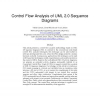Free Online Productivity Tools
i2Speak
i2Symbol
i2OCR
iTex2Img
iWeb2Print
iWeb2Shot
i2Type
iPdf2Split
iPdf2Merge
i2Bopomofo
i2Arabic
i2Style
i2Image
i2PDF
iLatex2Rtf
Sci2ools
ECMDAFA
2005
Springer
2005
Springer
Control Flow Analysis of UML 2.0 Sequence Diagrams
This article presents a control flow analysis methodology based on UML 2.0 sequence diagrams (SD). In contrast to the conventional code-based control flow analysis techniques, this technique can be used earlier in software development life cycle, when the UML design model of a system becomes available. Among many applications, this technique can be used in SD-based test techniques, model comprehension and model execution in the context of MDA. Based on the well-defined UML 2.0 activity diagrams, we propose an extended activity diagram metamodel, referred to as Concurrent Control Flow Graph (CCFG), to support control flow analysis of UML 2.0 sequence diagrams. Our strategy in this article is to define an OCL-based mapping in a formal and verifiable form as consistency rules between a SD and a CCFG, so as to ensure the completeness of the rules and the CCFG metamodel with respect to our control flow analysis purpose and allow their verification. Completeness here means if the CCFG metam...
| Added | 27 Jun 2010 |
| Updated | 27 Jun 2010 |
| Type | Conference |
| Year | 2005 |
| Where | ECMDAFA |
| Authors | Vahid Garousi, Lionel C. Briand, Yvan Labiche |
Comments (0)

